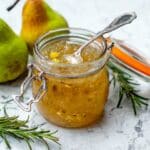Rosemary and Pear Jam Recipe
This Rosemary and Pear Jam recipe offers a delightful twist on traditional pear jam by infusing it with the aromatic flavor of fresh rosemary. The process involves macerating ripe pears with sugar and lemon juice to draw out their natural juices, then simmering with chopped rosemary until the jam reaches the perfect set. It’s an elegant, fragrant preserve ideal for spreading on toast, pairing with cheese, or adding depth to desserts.
- Prep Time: 12 hours 10 minutes
- Cook Time: 15 minutes
- Total Time: 12 hours 25 minutes
- Yield: 4 servings (approx. 3-4 half-pint jars)
- Category: Preserves
- Method: Stovetop
- Cuisine: American
Ingredients
Fruits
- 3 pounds ripe pears (such as Bartlett, Bosc, or Comice)
Other Ingredients
- 3 ¾ cups granulated sugar
- 2 tablespoons lemon juice
- 2 large rosemary sprigs (to yield 2 tablespoons chopped rosemary leaves)
Instructions
- Prepare chillers: Place 2 small saucers into the freezer. These will be used later to test if the jam has set properly.
- Prep pears: Peel the pears carefully, remove the cores, and cut the fruit into small, evenly sized pieces to ensure even maceration and cooking.
- Macerate pears: In a mixing bowl, combine pear chunks with the granulated sugar and lemon juice. Stir thoroughly until well combined. Cover the bowl and refrigerate for 12 hours to allow the pears to release their natural juices and soften.
- Chop rosemary: Finely chop the rosemary leaves from the sprigs until you have about 2 tablespoons of herbs to infuse the jam with a fresh, piney aroma.
- Combine ingredients: Transfer the macerated pear mixture along with its juices into a large, heavy-bottomed pan or pot. Add the finely chopped rosemary to the mixture.
- Dissolve sugar: Heat the pan uncovered over medium heat, stirring occasionally, until all of the sugar is completely dissolved into the fruit mixture.
- Boil jam: Increase the heat to high to bring the mixture to a vigorous boil. Continue cooking, stirring occasionally and skimming off any foam or scum from the surface, for about 15 minutes. Use a digital thermometer to check that the jam has reached 221°F, the setting point for jams. Stir constantly to prevent hot or cold spots and to avoid scorching.
- Test jam setting: Remove one saucer from the freezer, spoon a small amount of hot jam onto it, and let it cool for 30 seconds. Then, gently push the jam with your finger or a spoon. If the surface wrinkles, the jam is set. If not, return the jam to the heat and cook for an additional 5 minutes, then test again.
- Jar the jam: Once set, remove the pan from the heat. Carefully pour the hot jam into warm, sterilized, airtight jars. Seal immediately to preserve freshness. Label the jars with the date and contents once cooled.
Notes
- Using ripe, flavorful pears such as Bartlett, Bosc, or Comice ensures the best natural sweetness and texture.
- Macerating the pears overnight helps extract maximum juice and softens the fruit for a better jam consistency.
- Always use a heavy-bottomed pan to prevent the jam from scorching during boiling.
- Check jam temperature with a reliable digital thermometer for precise results.
- Sterilize jars thoroughly before filling to prevent spoilage and extend shelf life.
- This jam pairs wonderfully with cream cheese, toasted bread, or as a flavor enhancer in desserts.
Find it online: https://bitezly.com/rosemary-and-pear-jam-recipe/

